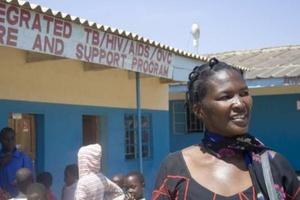Kenya: More funding needed for TB-HIV co-infection
HIV and tuberculosis advocates say failure by donors and governments to invest more in these diseases may thwart efforts to end both epidemics resulting in thousands of preventable deaths.
Tuberculosis (TB) is the leading cause of death among people living with HIV though it is preventable and treatable. According to a report launched by Global Health Partnership Initiative during the 20th International Aids conference in Melbourne, Australia (20-25 July), 320,000 people living with HIV died of the airborne disease in 2012.
This, advocates say, would have been prevented had donors invested more to address the dual infection. Furthermore, they have called for the integration of HIV and TB clinics saying that it is an easy and affordable way of addressing TB and HIV simultaneously.
Integrating TB and HIV clinics
Evaline Kibuchi, senior TB advocacy manager at KANCO, Kenya, suggests that integration of the two clinics would ensure all people tested for HIV are also screened for TB. “It is very sad that there are patients who test positive for HIV and though they are started on antiretroviral treatment, they soon find themselves in hospitals again with severe TB,” she notes. This, she adds, is not only expensive for the patient because they have to pay for their screening and transport to the clinics but is also time consuming.
Rudia Nalembedze, 48, is living with HIV and narrates how she gave up her efforts to get screened for TB because of long queues and the distance between the two clinics. “When I was referred to the TB clinic for screening at the HIV clinic, I thought it was next door only to board a cab to take me more than 3 km away where I found a long queue,” she says.
Having not been screened that day because of lack of time, Nalembedze tried the following day but experienced the same ordeal. She says: “I got tired and frustrated and gave up only to be thrown in the hospital bed for three weeks with acute TB a month later.”
Lack of funding
Kibuchi points out that there is dire need to have facilities available for people living with HIV to also screen for TB at no cost to ensure access to proper TB testing, treatment, and care. “It would be disgraceful for any country if people die of TB due to lack of money for screening,” she says. Kibuchi was a key speaker at the launch of the report, which recommends that when services are not located at the same clinic, incentives should be provided for affected communities to complete referrals.
People living with HIV in low income countries lament that diagnostic tests such as x-ray are too expensive for them. The report called for national TB programmes to reduce out-of-pocket costs for such tests to enable people living with HIV to go for screening with no duress.
Unfortunately, in low and middle income countries in most facilities the kits used often fail to diagnose TB in people living with HIV which demands more money from the patient should anoter test be needed from a better equipped facility.
Late diagnosis
Janet*, 36, from Kenya says by the time she got screened for TB, almost half of her lungs had been destroyed by the infection. She says she could not afford the Ksh. 500 (around US$6) to have an x-ray taken.
“By the time neighbours came to my rescue I could barely walk since I was very ill,” she says, adding that had the services been sponsored, she would not have suffered so much. Janet advises people living with HIV to have TB screening as soon as they can instead of waiting for the disease to penetrate deeper into the body and cause further pain and longer hospital stays.
For the HIV-TB response to be effective especially in sub-Saharan countries, more investment on the dual infection has to be made. A ‘one-stop shop’ for co-infected people would be a great leap towards addressing TB and HIV. These two infections remain partners in the majority of deaths and unless more funding is put into it, that partnership will continue.
Source: Key Correspondents


